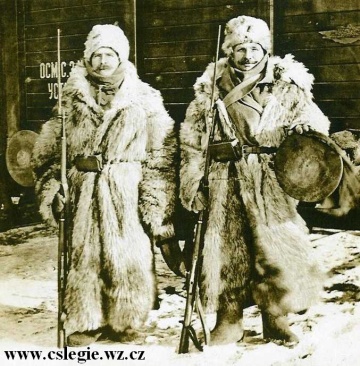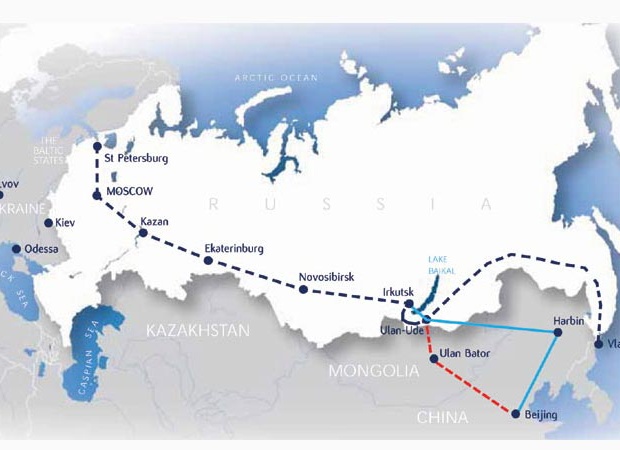Mohla by jsi prosím poradit? Manželův dědeček byl v Rusku jako legionář,byl zajat a pracovně nasazen . Nevím kam bych se mohla obrátit,abych pokud by to bylo možné, zjistit zda je uveden v nějakých dobových dokumentech ?
CZECHOSLOVAK LEGION
Categories: Wars
Volunteer military units, called the Czechoslovak Legion, began to be formed by representatives of the Czech and Slovak nations as a specific manifestation of foreign resistance. The very name "Czechoslovak Legion" was not coined until after World War I, during which they were units of Czechoslovak foreign troops.
 Many Czechs living abroad took a firm anti-Habsburg stance immediately in the summer of 1914 and, after public demonstrations, tried to join the fighting on the side of the Agreement. From the point of view of international law, it was a bit of a tricky situation. The Czechs offered themselves at the disposal of the governments of France, Great Britain, Serbia and Russia, but they did not receive a favourable response everywhere in the form of the formation of Czech troops.
Many Czechs living abroad took a firm anti-Habsburg stance immediately in the summer of 1914 and, after public demonstrations, tried to join the fighting on the side of the Agreement. From the point of view of international law, it was a bit of a tricky situation. The Czechs offered themselves at the disposal of the governments of France, Great Britain, Serbia and Russia, but they did not receive a favourable response everywhere in the form of the formation of Czech troops.
In France, where about 3,000 Czechs lived, the so-called Nazdar Company of 250 men was formed from Czech volunteers within the French Foreign Legion during September 1914. The unit's activities culminated in early May 1915 at Arras, where it achieved a short-lived successsuccess in the form of an advance to a depth of 4 kilometres, but at the cost of such losses that the company had to be disbanded into other Foreign Legion units. In June 1915, the so-called. Bérenger's Law forbade the admission of foreigners into the French army who were nationals of states at war with the Treaty, which, together with the factthe fact that there were no Czech prisoners of war in France, stopped the further formation of Czech volunteer units on the Western Front for a long time.
For the further fate of the Czechoslovak foreign resistance, the anti-Russian performance of the Czechs living in Russia was important. The formation of volunteer units in Russia was led by Czech associations in large cities. Their pro-Russian enthusiasm converged with the intentions of the Russian War Ministry, which 12. On August 1914, the War of War authorized the organization of a Czech unit, but on the condition that the volunteers had to add to their application an application for Russian citizenship, which entailed conversion to Orthodoxy. The resulting unit, numbering over 700 men (including 16 Slovaks) under Russian command, was called the Czech Companion, and the Russian Generalcamp, which in the autumn of 1914 had begun to enter the Czech lands, initially conceived of it as a kind of propaganda unit. However, the development of events led to the deployment of members of the Czech Companion (later the CzechoslovakCzechoslovak Rifle Regiment and Czechoslovak Brigade) in the form of small units as scouts. The Czechs did unusually well in these tasks, and this was the impetus for the Czech Russian command to allow further recruitment of Czech soldiers from among the large number of prisoners. One of the activities of Czech intelligence officers was their later exaggerated participation in the capture of some Czech units of the Austro-Hungarian army.
As a result of the individual action of the Kramar-oriented Josef Dürich, a dispute between Masaryk's team and the Russian compatriot associations over the concept of further action in the use ofuse of the numerous groups of Czech and Slovak prisoners of war in Russia, without whose recruitment the formation of an independent Czechoslovak unit of larger numbers would have been unrealistic. Due to the delay in the formation of a separate Czechoslovak army, many prisoners of war (especially officers of theprisoners of war) found their way into the ranks of the Serbian Volunteer Division formed on Russian territory from Yugoslav prisoners of war. The radical turn in Russia came as no other way than after the February Revolution of 1917, after which the Czechoslovak movement in Russia did not organize and for a time received permission for further recruitment of prisoners. The final change in the Provisional Government's view of the Czechoslovak Legions came with the Battle of Zborov on 2 July 1917. The success of the Czechoslovak Rifle Brigade, which fought for the first time as a tactical unit at Zborov, in a period of general decline of the Russian armed forcesforces prompted the Russian command to immediately authorize unlimited recruitment of prisoners and the creation of additional Czechoslovak units. A separate Czechoslovak army corps of 40,000 men was established on 9 October 1917, and in addition transports of several thousand Czechoslovak soldiers to France were begun.

Another dramatic change took place after the Bolshevik coup in 1917. Although the Czechoslovak Army Corps was declared part of the French army at the end of December and beganIt soon came into conflict with the Bolsheviks, who blocked the legionary transports to the east. The situation escalated in May 1918 with the famous Chelyabinsk incident, after which the Czechoslovak legionnaires decided to make their own way to the port of Vladivostok. In a short time they managed to get the whole Siberian main line under control, build up a good base and create the so-called Eastern Front. The surprising success of Czechoslovakia in Russia aroused the interest of the Agreed Powers and considerably strengthened the position of the Czechoslovak National Council. The subsequent deployment of the Russian legions, whose numbers gradually exceeded 100,000 men, in the fighting against the Bolsheviks proved too exhausting and fruitless. From the end of 1919 the Czechoslovaks began to withdraw from Siberia, the last Czechoslovak transport leaving Vladivostok on 2 September 1920. However, a large number of Czechs and Slovaks also took part in the Civil War on the side of the Bolsheviks, perhaps the most famous of them being Jaroslav Hašek.
In France, where on 19 December 1917 President R. Poincaré authorized the establishment of an independent Czechoslovak army, Czechs and Slovaks formed two rifle corps from among Serbian prisoners of war, Russian legionaries and compatriots from the USA during 1918 regiments, later formed into the Czechoslovak Rifle Brigade of about 100,000 men, which in October 1918, under French command, intervened in the battles of Vouziers and Terron. After the formation of two more rifle regiments, the 5th Czechoslovak Rifle Division was formed, which was transported via Italy to Czechoslovakia in early 1919 and deployed to fight in Slovakia.
After 1915, large numbers of Czech and Slovak prisoners of war gradually regrouped in Italy, whose attitude to the formation of Czechoslovak troops was for a long time rather reserved.It was not until the second half of 1917 that the Italian government allowed the formation of Czechoslovak labourThe Czechoslovak government soon gained the respect of the command, as it had on the Russian front. On 21 April 1918, the Italian government finally signed an agreement to create a Czechoslovak army in Italy, and shortly afterwards the 6th Czechoslovak Rifle Division was formed with Italian leadership. From June 1918 onwards, Czechoslovak legionnaires were deployed to the front, with success, but also with losses - including prisoners of war who were executed. The culmination of the 6th Division's combat activities was the battle for the important peak of Doss Alto, where on 19 September the Czechoslovak Legionnaires successfully repulsed an Austro-Hungarian attack. Already after the end of the war, a Czechoslovak Army Corps was formed in Italy with a strength of 20,000 men, which was deployed in the fighting in Slovakia. In addition, 55 Home Guard battalions of 60,000 men were formed in Italy from Czech and Slovak prisoners of war who had enlisted in the Czechoslovak foreign army after 28 October 1918 and returned to Czechoslovakia during the first half of 1919.
http://www.svedomi.cz/ (article Czechoslovak Legions, by Doc. PhDr. Tomáš Pavlica, CSc.)
http://www.cslegie.wz.cz/
Wiest, A.: IMAGE HISTORY OF THE FIRST WORLD WAR
You can search for artefacts from this period using our metal detectors.
The article is included in categories:
Post
Existují stránky www.pamatnik.valka.cz, podívej se tam. Možná ti to pomůže:) Jsou tam nějaké informace o československých legiich a taky kontakt na prezidenta památníku čestně padlých, zkus mu napsat, třeba bude vědět víc
Jahodo, zkus to tady: http://www.vuapraha.army.cz/. 90% lidi jsem tam našel. Totéž neplatí o II.sv.v.
Díky oběma za odpověď, moc toho o dědovi nevíme,nijak zvlášť o svém mládi nemluvil.
Více informací o čs. legiích najdete na www.karelvasatko.cz . Pomůžeme Vám s dohlednáním předka - legionáře a dozvíte se zde určitě spoustu zajímavých informací ... 











